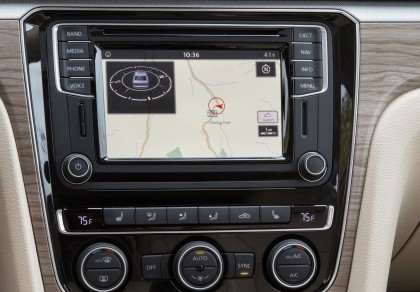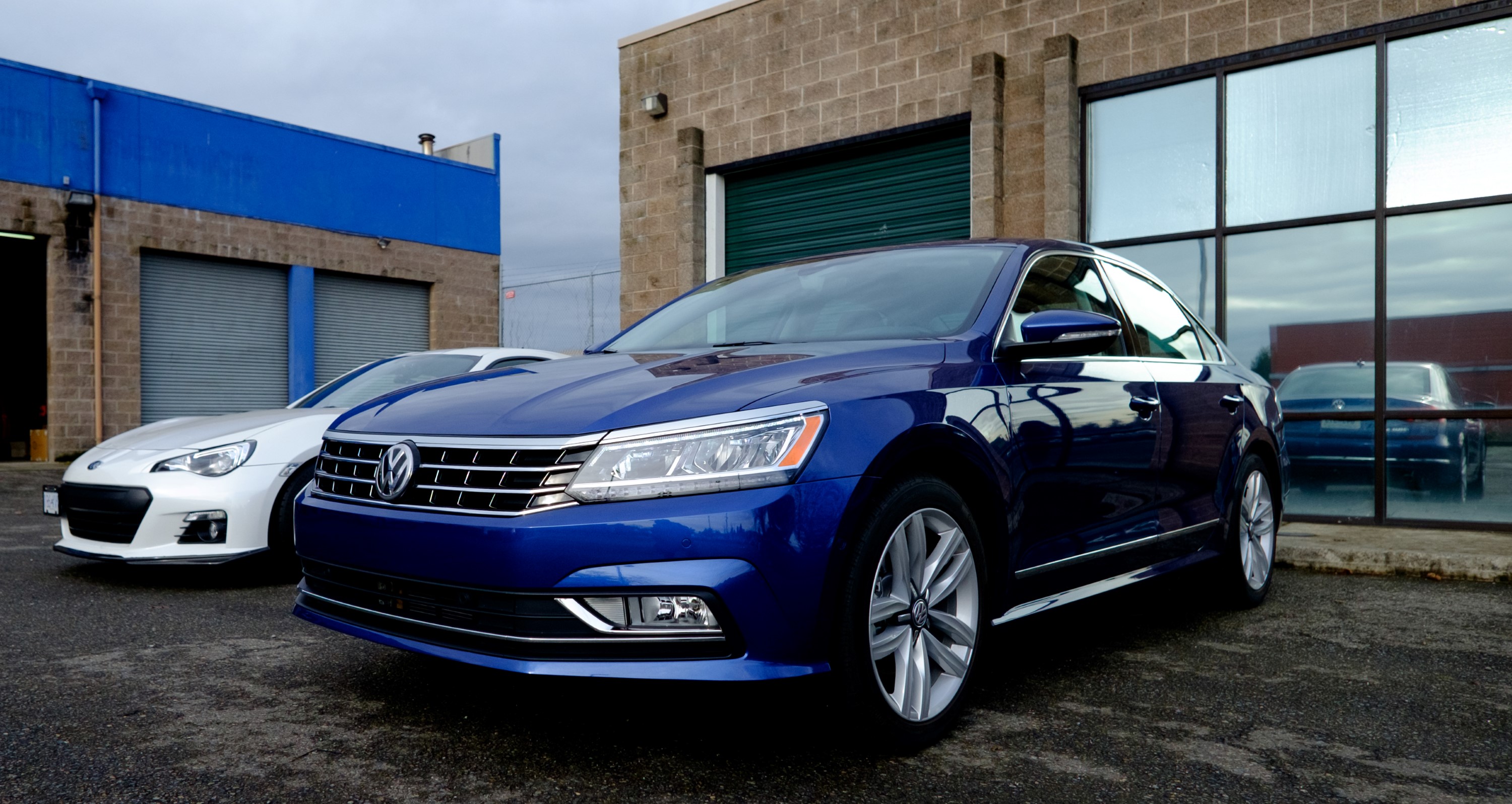Early Verdict
The VW Passat is better than ever when it comes to technology, but this German sedan falls behind some tough competition with larger screens and more functional driver assists.
Pros
- +
Apple CarPlay and Android Auto
- +
Responsive, matte capacitive touchscreen
- +
Park assist and lane keep assist technology
- +
Rear USB data port
Cons
- -
Adaptive cruise control can't stop the car
- -
Display is small
Why you can trust TechRadar
Volkswagen (VW) pulled the wraps off its updated Passat at the New York International Auto Show in September. The update included minor visual tweaks, new driver assist technologies and, most importantly, VW's second generation, modular infotainment system (MIB) that brings Apple CarPlay and Android Auto into the fold.
As I wait for the new 2016 Passat to become available for a detailed review, VW drove through Washington (the state) for a regional media tour with a well-equipped Passat SEL Premium packing the 1.8-liter, turbocharged power plant. I was able to spend an hour with VW and the updated Passat, testing the new infotainment system and driver assist technologies.
Infotainment
The Passat SEL Premium I tested out features the latest VW Car-Net App-Connect infotainment system with integrated navigation, or MIB II. VW offers the same system without native navigation functions on lesser SE trim levels, too.
Previous Passat models offered two choices of navigation: the RNS 315 and RNS 510. I've spent quite some time with the RNS 315 in multiple cars, and it was one of the worst infotainment systems available in a modern car, thanks to its 5-inch screen with a resolution of 400 x 240 pixels and lack of basic USB ports. The optional RNS 510 infotainment system wasn't as bad, with a sharper display and better graphics, but I've only spent 5 minutes with that version.
Fortunately, the VW MIB II infotainment system is a significant upgrade to previous solutions, at first glance. The 800 x 480 screen resolution may seem low in the world of 4K and WQHD smartphones, but the graphics look clean without jagged edges from the driver's seat.
VW claims that the MIB II has a glass, capacitive touchscreen with multi-finger touch, which is typically glossy with plenty of glare, instead of the traditional, plastic resistive touchscreen (single-touch). However, the display employed in MIB II has the smooth responsiveness of capacitive touchscreens combined with a matte coating and feels more reminiscent of resistive touch panels.
The result is a touchscreen that responds well to my touch, but doesn't suffer major glare from sunlight.
Sign up for breaking news, reviews, opinion, top tech deals, and more.

While the 6.5-inch display may seem small when the Kia Optima offers an 8-inch display, VW employs a proximity sensor to maximize the available screen real estate. Take the native navigation display, for example. When you're looking at the navigation screen, it takes up the entire display, so you only see the map.
If you bring your hand closer towards the screen, the proximity sensor springs into action and brings up on-screen buttons for additional functions, like address input, POI search and other navigation tools. It seemed annoying at first, as I would rather see the on-screen buttons at all times.
But thinking longer on it, this shouldn't be a problem if the Passat is your daily driver and you are accustomed to the layout. I got used to the proximity sensor quickly, despite my brief time with the Passat.
The biggest usability upgrade with the MIB II is standard USB ports. Previous VW infotainment systems had a proprietary media digital interface (MDI) that typically included a 30-pin iPod dock connector, which hasn't been used by new Apple devices for many years. MIB II adds two USB ports: one in the front and one for back seat passengers.
Only the front USB port supports CarPlay and Android Auto. However, the rear USB port isn't just for charging. Rear passengers can plug-in their own iPhones or USB flash drives loaded with music and let the driver select music from the rear port.
I measured power output from the front USB port using my trusty Drok USB power meter, an iPhone 6S and Nexus 6. With the iPhone 6S, the device was able to pull up to 1.0 amps but stayed around 0.9 amps for charging. My Nexus 6 hovered around 0.8 amps. While the iPhone 6S should have no troubles charging with the car's power output, power-hungry Android phablets will charge slowly if you're out of juice.
Apple CarPlay & Android Auto-ready
VW is smartphone agnostic when it comes to connectivity. Passat buyers will get access to CarPlay and Android Auto as soon as they purchase the car. There's no later availability for either via an update, like the Hyundai Sonata and Kia Optima with CarPlay, or the latest Hyundai Tucson with both features missing, fortunately.

When a supported smartphone is plugged in, CarPlay or Android Auto does not start automatically. Instead, you have to manually launch the CarPlay or Android Auto app on the infotainment system to activate the user interface.
I got to experience CarPlay with an iPhone 6 in the Passat. The VW representatives had a phone prepared for the demo ahead of time.
When a new phone is plugged in, you're supposed to get a pop-up confirmation in iOS 9 to accept the connection, but that didn't happen when I plugged my own phone in. I'm not sure what the exact problem is, but there wasn't much time to troubleshoot with the short demo window.
Functionality is straightforward, with a familiar 4 x 2 grid layout of supported CarPlay apps and an on-screen home button in the bottom left of the display. Your phone, music, maps, messages and all other apps work as they would on your iPhone.
It's essentially mirroring your phone display but not allowing access to most of your apps. There wasn't noticeable lag while swiping through the available apps, but it was an uninspiring interface. Audio is sent to the car via the USB cable, so quality is as good as your source file.
Speaking of which, Google's in-dash interface offers much better functionality than CarPlay, thanks to Google Now. I plugged in my Nexus 6 into the MIB II system and accepted the accompanying prompts on my device. I find Android Auto much more usable with Google Now because it integrates with my Google-owned life.

Since Google knows where my home is and has access to my search settings, it makes sending addresses to the car simple. I can search for an address via Google Maps on my desktop, hop in the car, connect the USB cable for Android Auto and Google Now gives me an estimated time to the place I just searched for.
From there, I can select the location via the vehicle's screen and use Google Maps to navigate. It shows my calendar, Hangouts, estimated time to places I frequent – all in the familiar Google Now interface.
I found Android Auto performance as smooth and responsive as with CarPlay. I'm not a fan of audio over Bluetooth, since the quality is never able to match a wired connection, but that's Google's problem – not Volkswagen's.
Don't have the latest and greatest? Try MirrorLink
MirrorLink is the last trick up VW's sleeve in regards to phone connectivity. This is not something that was demoed or a tested feature, since my Nexus 6 does not support it.
The technology is based on virtual network computing and predates CarPlay and Android Auto. MirrorLink sounds just like the name implies: it mirrors your phone display with access to supported apps only, like CarPlay and Android Auto.
Samsung and HTC support MirrorLink with the latest Samsung Galaxy S6, Note 5 and HTC One M9. I'm not sure why anyone would bother with MirrorLink when all Android phones made in the last year or two that support it also run the Lollipop operating system or better, which is Android Auto compatible.
MirrorLink is quite popular in Europe, supposedly, but aside from those rocking older Symbian-based Nokia phones, you're better off using Android Auto.
- 1
- 2
Current page: Infotainment, Android Auto and CarPlay
Next Page Driver assists and our early verdictWhat is a hands on review?
Hands on reviews' are a journalist's first impressions of a piece of kit based on spending some time with it. It may be just a few moments, or a few hours. The important thing is we have been able to play with it ourselves and can give you some sense of what it's like to use, even if it's only an embryonic view. For more information, see TechRadar's Reviews Guarantee.
